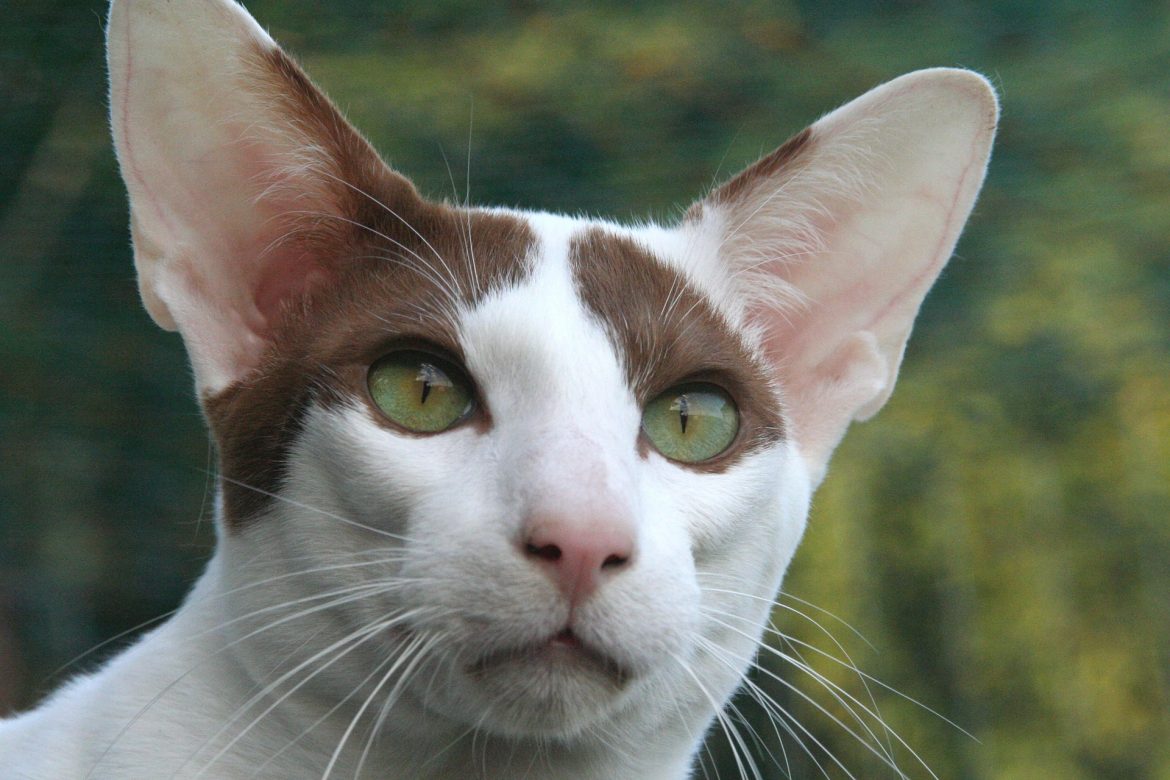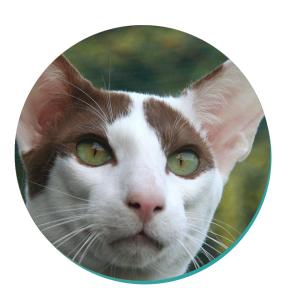This distinctive breed is full of fun secrets, and is beloved by Cat Sitters in Adelaide, Darwin, and everywhere else! Learn more about the history, personality, and needs of the Oriental Shorthair.
Quick Facts
Weight – 4 – 6.5kg
Lifespan – 15 years
Best breed for:
- Large families
- Households with other pets
- Owners who can commit to ample playtime
Oriental Shorthair Breed History ♜
The Oriental Shorthair is a modern cat. And we don’t just mean that because they’ve been taking Instagram by storm. These cats have only been around since the 1950s. Unfortunately, they didn’t exactly have an easy start.
Oriental Shorthairs are an offshoot of the Siamese, a cat breed that was dedicated to continuity in colouration. Breed standards would only accept blue eyes. Plus, any cats that didn’t have the characteristic coat colours – white or cream bodies with dark points – were decidedly not Siamese. In fact, solid colours or any other variations in coat were called “foreign shorthairs.”
Well, the imperfect Siamese cats weren’t rejected wholeheartedly. Some breeders swept up these not-quite-Siamese cats and created a new breed: the Oriental Shorthair. Early Oriental Shorthairs were bred with Russian Blues, Abyssinian Cats, British Shorthairs, American Shorthairs, and a few other breeds.
Lineages branched off during this time in a few different directions. From these early breeding programs, we now have our star of this corner, the Oriental Shorthair, but there’s also the Havana Brown and the Oriental Longhair. Today, some breeders continue to breed within these few breeding pools – Siamese, Oriental Short and Longhairs, and Havanas – to encourage genetic variation for health reasons.
The Oriental Shorthair gained formal recognition by the Cat Fancier’s Association in 1972, and has been rising in popularity ever since.
Today, you can see Oriental Shorthairs in a range of different colours – almost 300 combinations! But, you can always spot this breed by their distinctive long face, wide-set bat-like ears, and sleek, long body. They also have a razor-thin tail compared to some other breeds.
Oriental Shorthair Personality Traits ★
Oriental Shorthairs are vocal, smart, and attention-seeking (we mean that in the most loving way possible.) When you bring one of these feline friends home, be ready for your house to be filled with personality.
Oriental Shorthairs want to be involved in whatever their Owners are doing. If you’re looking for an independent cat, this might not be the furry friend for you. But if you’re looking for a constant companion, a lap cat, an entertainer, a life of the party, then the Oriental Shorthair will meet all of your requirements.
These are also agile cats. With their tendency to climb to the highest point in the room, the Oriental Shorthair really does look like a cross between a bat and a cat. And when they’re not perched up high, they’re likely running, playing, and otherwise engaging in some athletic pursuit. Oriental Shorthairs are notoriously rambunctious, so be ready for a cat that is going to make the most of their space.
The last thing you should know about the Oriental Shorthair’s personality is that they are very smart. And, take a look at their lineage. Abyssinian Cats, Siamese, and Havana Browns all consistently rank among the smartest cat breeds in the world. If you’ve ever been around an Oriental Shorthair, it probably surprises you that they’re not first on the list.
Overall, then, you have a cat that is active, a bit on the needy side, and intelligent. Training and play is going to be essential.
Oriental Shorthair Trainability and Training Tips
Play and training are two ways to make sure your Oriental Shorthair is happy and healthy. And when a cat is happy and healthy, they’re not tearing up your house. Luckily, Oriental Shorthairs are easy to train. They love to make their Owners happy, and they’ll find training sessions exciting and fun.
The best way to go about training an Oriental Shorthair is to draw upon their strengths and natural instincts. They love to climb, they love affection, and they love to chat with you. These three elements can make your training sessions rich and rewarding for both you and your cat.
You might train your Oriental Shorthair, for instance, to ride around on your shoulder like a parrot or jump through your arms. You might set up a house-wide agility course that ends with lots of treats and cuddles. There are also fun ways to train your Oriental Shorthair to use vocalisations to get rewards (after all, they’re going to talk anyway, you might as well reign it in.) The possibilities are endless.
The main thing to keep in mind is that training should be regular and life-long. Keeping your kitty engaged and well-exercised is key to their happiness.
Living Conditions ⌂
Living with an Oriental Shorthair can be both entertaining and a bit of a challenge. If you were to put an Oriental Shorthair in a room with nothing more than a chair and a lamp, you would come back to find that they had magically procured a variety of things to play with. Maybe they had ripped up a patch of carpet. Maybe they unscrewed a bolt from the lamp.
What we’re getting at is that these cats are crafty. Without the right setup, your Oriental Shorthair will turn their attention to your home and belongings. For that reason, it’s important to have adequate places for your feline friend to run around, climb, and explore. Provide them with plenty of cat toys and remember to schedule playtime every day. Your Oriental Shorthair will also love the opportunity to look outside. They also like to watch television.
One crucial part of living with an Oriental Shorthair is that they need ample social time. This is not a great cat for families that work a lot and can’t spend time with their cat. Instead, they love a full house and will even get along with dogs and other cats (as long as everyone’s been properly trained and socialised, of course.)
Oriental Shorthair Health and Grooming ✄
Oriental Shorthairs are prone to some of the genetic disorders common in Siamese Cats. Here are a few of the most common:
- Amyloidosis
- Crossed eyes
- Progressive retinal atrophy
- Congenital heart defects
Always make sure that your Oriental Shorthair comes from a responsible source to minimise the risk of genetic disorders. Or, if you’re adopting your Oriental Shorthair, make sure that they get regular checkups with a vet to make sure they’re healthy.
A good thing about the Oriental Shorthair is that you can easily see if they’re over- or under-eating. An overweight Oriental Shorthair will have an easily noticeable belly and an underweight one will have protruding hip bones. Even slight changes are easy to see so that you can know if you need to change their meal sizes or take a trip to the vet. You can learn more about managing weight in our article on helping your cat lose weight.
Grooming an Oriental Shorthair is easy. They’ve got a short, shiny coat that just needs a brush with soft bristles every few days. This breed is pretty close to hypoallergenic, and their coat is soft and easy to manage
Fun Fact ♥
One quirky habit of the Oriental Shorthair is that they love to climb into small spaces to find treasures and toys. Sure, all cats do this to some extent, but the Oriental Shorthair takes the task seriously.
If you’re looking for your Oriental Shorthair, chances are, they’re digging around in your sock drawer, your purse, or even the fridge. These wily little kitties are great at opening doors, cabinets and drawers, and they’ll stop at nothing when they’re bored.
The best way to deal with a burrowing cat is to channel that behaviour to other areas of the house. Maybe you can put treats in a couple of boxes or hide toys in empty drawers so that they spend time digging around in safe areas. Otherwise, you might find your kitty trying to climb into the clothes drier.
Final Thoughts on the Oriental Shorthair
This cat might have started out being turned away from the Siamese breed standard party, but they’ve found their true home in the cat loving community.


